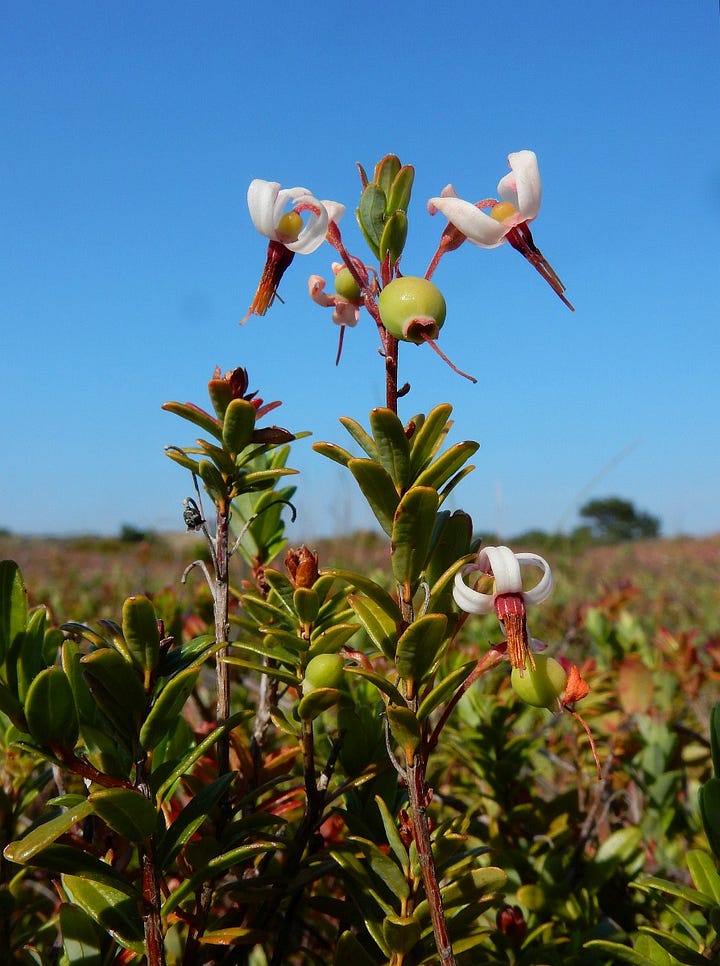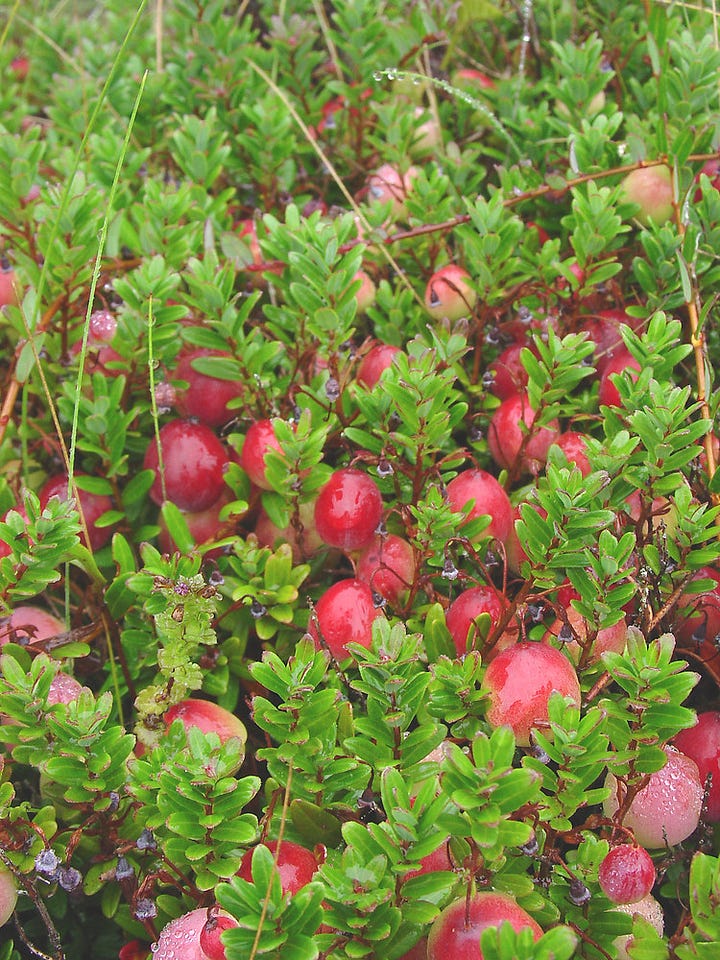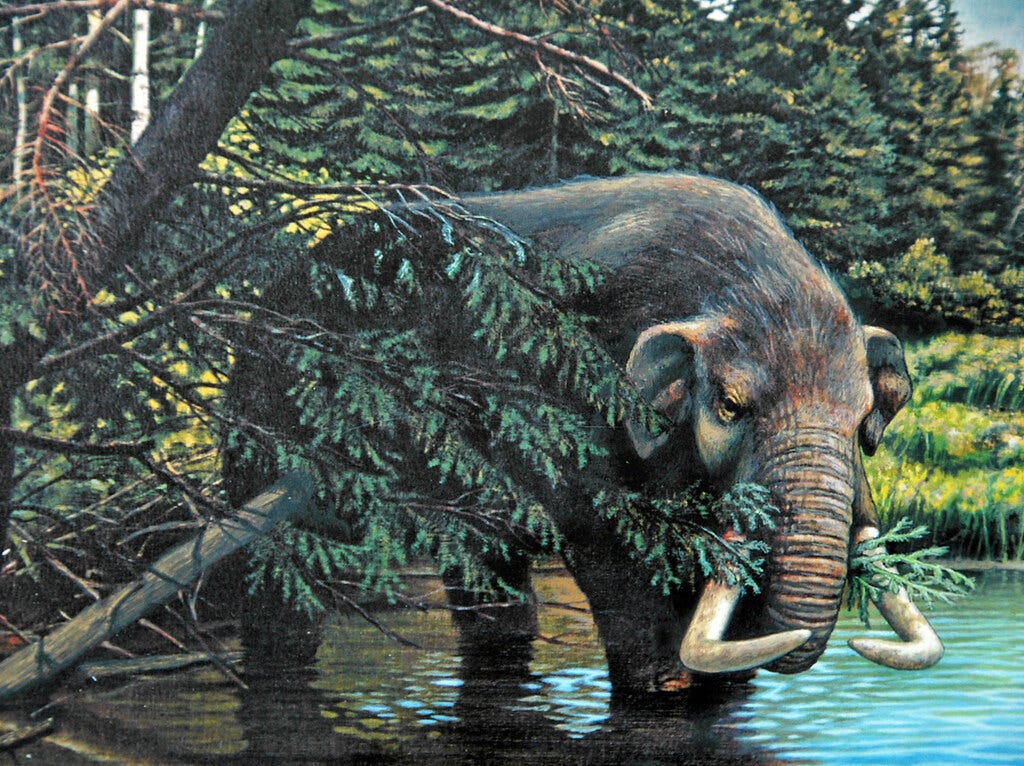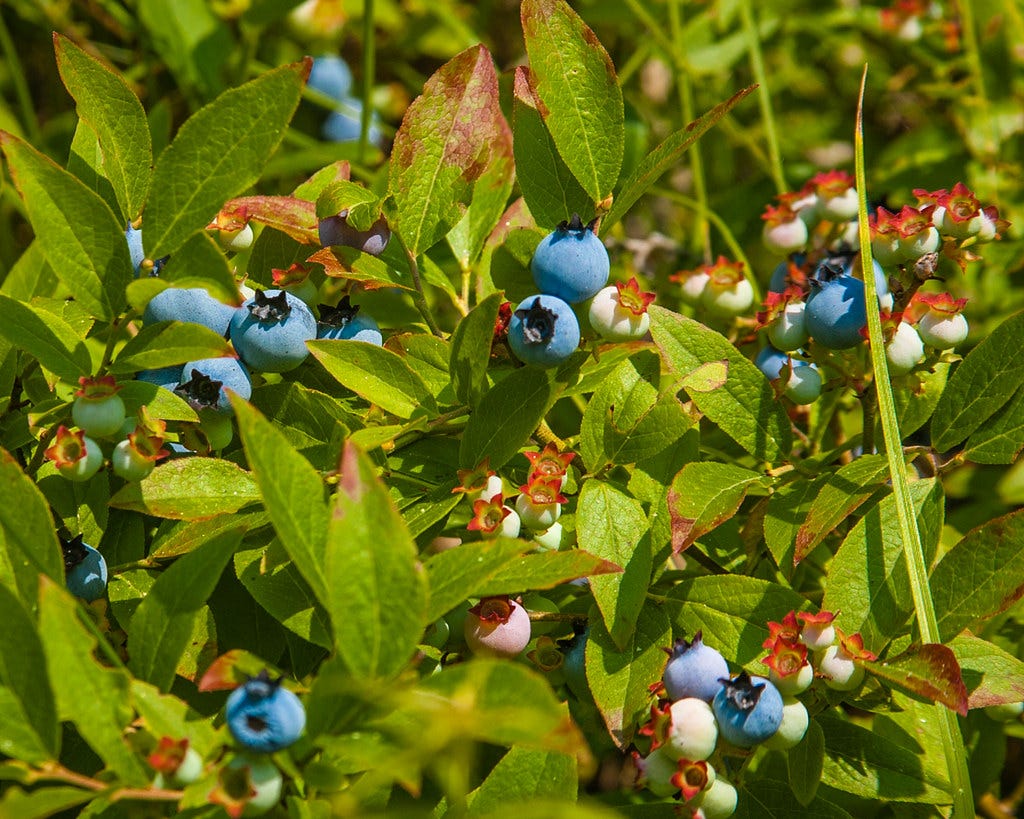ALSO KNOWN AS: Ibimi (Pequot), Vacciunium macrocarpon, sasemineash, pakim (Lenni-Lenape), Wathgusuje (Otoe-Missouria)
How to know:
Creeping shrubs
Pink flowers with petals that curl back
Stamens that are clumped in a single downward pointing ray
Glossy thick leaves
Alternate leaf patterning


The crane walks through the water as slow as an unfurling leaf. Its head bows in deep concentration as its legs move with a razor precision. From some angles the crane disappears completely in a trick of the light as its narrow body collapses into a singular line.
I had a dream of a crane once. It stood in my grandmother’s basement which was also a swamp. In a grotesque act to protect the bird, I crushed a snake’s head before it could bite either of us. This was the first of many snake dreams that would follow in the months to come. The crane, it turns out, in ancient Egyptian mythology, is the snake killer. The stalker of shallow waters is named after the cranberry. But the mythology of killing great and powerful beasts follows this low growing plant.
Cranberries grow in acidic bogs, a marshland that is a remnant of a glacial path. Bogs are depressions in the land fed by spring water and held together like bowls by a clay or sandy base. The build up of peat, or dead plants, soaks to a make a steeped ecosystem which many plants thrive on.
Cranberries are native to the bogs of the northeastern United States and have been an important source of food and medicine for thousands of years. Now cranberries are a popular commercial berry grown in Massachusetts, Wisconsin, and New Jersey. Yet they’ll never have the allure of the mountain blueberry or delight of early summer strawberries. Despite their sweetness, these bog haunts have a famous bite that follows them through mythology and into medicine and dining room tables.
From the Time of Mastodons
The Pequot people native to Cape Cod name the berry “ibimi”, the Lenni Lenape, the pakim, both of which roughly translate to “bitter berry”. They are an important food for sustenance over the winter. They are dried and prepared with bison, venison or meat in the first “granola bar” which is meat and cranberry bar called pemmican that can be eaten during long travels or when other food is scarce. Cranberries are also prepared in the corn-based dish called succotash.
Imagine what it was like for the paleo peoples to fight a mastodon. Imagine the poise and teamwork that was involved in the hunt. Imagine the preparation required both before and after the kill. As modern monsters consume us in deeply subtle ways, the beasts that roamed and managed landscapes before modernity rose its zombie head, the beasts which all of our ancestors had to contend with required us to use every bit of our savvy to kill - and ultimately use.
The Lenni Lenape have a story that goes back to their ancestors, the paleolithic Americans that tells of the origin of cranberries. The creatures of the earth fought against and could not come from under the rule of the mastodons. It is said in some versions that the Great Spirit came to help, that the mastodons became extinct, and from their bodies - and in remembrance of the pain of this battle - the cranberry rose from the bloody field to represent a bitter peace, a remembrance and an emblem of gratitude and friendship.
The cranberry continues to be a sacred plant to the indigenous peoples along the Atlantic Coast. To the Lenni Lenape whose land spans around what is now Connecticut down to Delaware, the cranberry is a symbol of peace. The simultaneous beauty and bitterness in the plant tells how peace is not always an easy place to be. It can come out of great loss and sacrifice, nor is it static.
When we make peace we give a part of ourselves away for someone else to keep safe.
The cranberry is in the heath family, a group that has adapted to cold, damp, and high altitude locations. They are in the Ericaceae family, closely related to the lingonberry, blueberry, and heather. Similar to the heathland where heather grows in mats, so too, the cranberry grows in tight bunches. Unlike the bell shaped flowers of cross leaved heath, however, the flowers of the cranberry peel open and up, their sepals face down with pollen laden tendrils. They are pollinated primarily by bees that use a drumming method to release pollen. Though the cranberry doesn’t carry much pollen on the tight column of stamens that fuse to a point like a beak on the flower. The pollen that it does have is particularly full of protein, making it a healthy food, full of amino acids and tissue healing properties.
The cranberry vines can crawl along the ground in lengths of up to eighteen feet. Along with the blueberry, these are known as dwarf shrubs because they have woody stems, but will never grow tall, leaving miniature forests in the muck. The small glossy evergreen leaves hug the small stems on top of which the flowers nod.
As the cranberries develop, they turn from green, to white, and then a deep red and once they are mature. At this point they will hold about thirty five seeds nestled in four vestibules in the otherwise spongy fruit. Cranberries don’t like to be swallowed by the dozen like a blueberry which is so softly sweet to the human tongue. No, the cranberry requires thought and preparation before eating. It is so tart that even sugar can’t cut its blade. In this way cranberry is usually eaten in moderation. Once cranberries were introduced and adapted to colonial households, people started adding sugar from the Caribbean and South America into cranberry dishes.
Now cranberry sauce is one of the staples of Thanksgiving - a holiday with a convoluted and confusing history. While that effusive feast truly did happen in Plymouth between colonists and the Wampanoag, who may well have brought cranberries. That peace was eventually ruptured and forgotten until Lincoln created a thanksgiving to bring the unsteady America together after the Civil War.
Slippery Compounds
Cranberries are endlessly healthy. The plants are rich in vitamin C. They were used aboard ships to prevent scurvy. They promote immune health and are antimicrobial.
In 1917 Elizabeth Lee, of New Jersey, made a canned sauce she called "Bog Sweet," which would later be incorporated into the business owned by Marcus Urann. This company became Ocean Spray, shedding the unsexy bogness inherent in cranberries. But let it be known: there would be no cranberry without the bog.
In a globalized world with many crops grown far from their native ranges, the cranberry stays close to its location. Outside of the United States, it is only cultivated in Canada and Chile.
If cultivated commercially, farmers will famously flood the fields so that the berries rise to the top in a buoyed red cloud before harvesting them. This bruises the cranberry, ideally a ripe cranberry is handpicked and will bounce. This is why Ocean Spray, who patented the flooding of the cranberry bogs. The flooding may be more convenient for large-scale farming. There are varying opinions about the health of the flooding cranberry bogs, but it is generally wasteful of water and disruptive to bog ecosystems. Cranberry harvests take place in October and early November. But the plants themselves don't need that flooding, they only need moist soil throughout the year.
The cranberry plants have been used for wound healing as an antimicrobial that could be eaten or made into a poultice. The deep red is also made into a deep red dye. Studies are being done to prove the berry’s usefulness in treating serious issues such as heart disease, cancer, and gastrointestinal disorders. But I know cranberries as a home recipe.
I have been in countless bathrooms with my best friends chatting, when, in passing, they mention the UTI that has come back again. They’re back to drinking cranberry juice.
As women in our early 20’s we had a few remedies we gave to one another: honey, peppermint, and cranberry, shoulders, hands to hold, canned squash soup. When I feel these things I think of my closest women friends, these tastes, these gestures, and cranberry. It turns out this medicine probably worked. Most urinary tract infections are brought on by a development of Proteus mirabilis, a long cell with wavering strands all around. Cranberries have proanthocyanidin, a part of which makes them deep and red. This compound has the ability to release the hold bacteria can have on cells. In this way it is used to make the bacterias of UTI’s, infections, and ulcers slippy so they will not take hold.
Perhaps this lovely slippage, this simultaneous equanimity and strength embedded in the berry is what keeps us projecting stability upon it. The cranberry will live on without us, slipping into other times, meeting the mastodons of the future.
myth for cranberry
Not to be confused with blueberry. They are in the same family, both woody shrubs, and downcast flowers
Or Kinnikinnick. These are low shrubs with red berries and glossy leaves, but their leaves are smaller, and their berries are rounder. These berries can grow in boreal, subarctic conditions. They are edible also!
Forager Friendly?
Yes!
Sources:
https://www.almanac.com/all-about-cranberries-american-native
https://tankabar.com/collections/bars
https://www.almanac.com/cranberries-get-em-while-you-can
https://www.youtube.com/watch?v=QttkrRbC8AQ
https://www.youtube.com/watch?v=toAJsqZYKfc
https://www.indigikitchen.com/pemmican/
https://www.nytimes.com/1973/10/21/archives/the-cranberrry-ruby-of-the-barrens-new-picking-method-taken-on-a.html (a dated, strange; but interesting article)
https://www.nj.gov/pinelands/infor/educational/curriculum/pinecur/tcs.htm
https://archive.org/details/legendofcranberr00gree/page/n37/mode/2up
https://lenapeprograms.info/lenape-delaware-indian-resources/lenape-history/
https://www.omtribe.org/wp-content/uploads/CranberryWildRice_allon2pages_OM.pdf
https://delawaretribe.org/wp-content/uploads/LENAPE-NAMES-OF-FOODS.pdf
https://open.spotify.com/episode/38eRyQ0dkLO5ncAYbGJ2jz
https://www.minnesotawildflowers.info/shrub/large-cranberry







Yes, I take cranberry pills every day, and guess what: no UTIs!
Thanks for this creative take on the cranberry. We take it for granted at our peril!